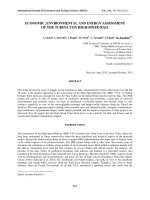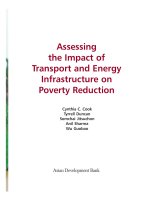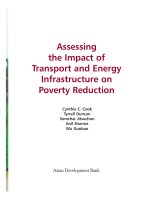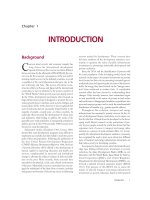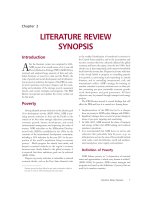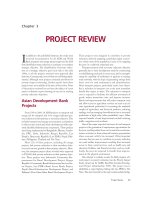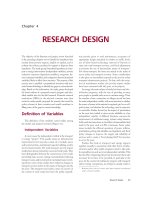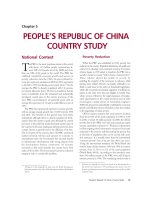- Trang chủ >>
- THPT Quốc Gia >>
- Hóa
Glencoe science module m motion, forces, and energy mcgraw hill 2005
Bạn đang xem bản rút gọn của tài liệu. Xem và tải ngay bản đầy đủ của tài liệu tại đây (26.88 MB, 245 trang )
i-01-LBM-861770
08/17/2004
6:47 AM
Page i
Gunter Marx Photography/CORBIS
i-01-LBM-861770
08/17/2004
6:47 AM
Page ii
Motion, Forces,
and Energy
This kayaker battles the rapids
on the Thompson River in
British Columbia, Canada. A
kayaker takes advantage of
Newton’s third law. The paddle
exerts a force on the water and
the water exerts an equal, but
opposite, force on the kayaker.
Copyright © 2005 by The McGraw-Hill Companies, Inc. All rights reserved. Except as permitted under
the United States Copyright Act, no part of this publication may be reproduced or distributed in any
form or by any means, or stored in a database or retrieval system, without prior written permission
of the publisher.
The National Geographic features were designed and developed by the National Geographic Society’s
Education Division. Copyright © National Geographic Society.The name “National Geographic Society”
and the Yellow Border Rectangle are trademarks of the Society, and their use, without prior written
permission, is strictly prohibited.
The “Science and Society” and the “Science and History” features that appear in this book were
designed and developed by TIME School Publishing, a division of TIME Magazine.TIME and the red
border are trademarks of Time Inc. All rights reserved.
Send all inquiries to:
Glencoe/McGraw-Hill
8787 Orion Place
Columbus, OH 43240-4027
ISBN: 0-07-861770-7
Printed in the United States of America.
2 3 4 5 6 7 8 9 10 027/111 09 08 07 06 05 04
Gunter Marx Photography/CORBIS
i-01-LBM-861770
08/17/2004
6:47 AM
Page iii
Authors
Thomas McCarthy, PhD
Dinah Zike
Education Division
Washington, D.C.
Science Department Chair
St. Edward’s School
Vero Beach, FL
Educational Consultant
Dinah-Might Activities, Inc.
San Antonio, TX
Deborah Lillie
Margaret K. Zorn
Math and Science Writer
Sudbury, MA
Science Writer
Yorktown, VA
Series Consultants
CONTENT
Jack Cooper
Teri Willard, EdD
Sandra West, PhD
Ennis High School
Ennis, TX
Mathematics Curriculum Writer
Belgrade, MT
Sandra K. Enger, PhD
Department of Biology
Texas State University-San Marcos
San Marcos, TX
READING
Associate Director, Associate
Professor
UAH Institute for Science Education
Huntsville, AL
Carl Zorn, PhD
Staff Scientist
Jefferson Laboratory
Newport News, VA
MATH
Michael Hopper, DEng
Barry Barto
Special Education Teacher
John F. Kennedy Elementary
Manistee, MI
SAFETY
Aileen Duc, PhD
Science 8 Teacher
Hendrick Middle School, Plano ISD
Plano, TX
Manager of Aircraft Certification
L-3 Communications
Greenville, TX
ACTIVITY TESTERS
Nerma Coats Henderson
Pickerington Lakeview Jr. High
School
Pickerington, OH
Mary Helen Mariscal-Cholka
William D. Slider Middle School
El Paso, TX
Science Kit and Boreal
Laboratories
Tonawanda, NY
Series Reviewers
Sharla Adams
Joanne Davis
Michelle Mazeika-Simmons
IPC Teacher
Allen High School
Allen, TX
Murphy High School
Murphy, NC
Whiting Middle School
Whiting, IN
Sandra Everhart
Mark Sailer
John Barry
Dauphin/Enterprise Jr. High Schools
Enterprise, AL
Pioneer Jr-Sr. High School
Royal Center, IN
Seeger Jr- Sr. High School
West Lebanon, IN
Nora M. Prestinari Burchett
Saint Luke School
McLean, VA
Lynne Huskey
Chase Middle School
Forest City, NC
M
◆
iii
i-01-LBM-861770
08/17/2004
6:47 AM
Why do I need
my science book?
Have you ever been in class and
not understood all of what was
presented? Or, you understood
everything in class, but at home,
got stuck on how to answer a
question? Maybe you just
wondered when you were ever
going to use this stuff?
These next few pages
are designed to help you
understand everything your
science book can be used
for . . . besides a paperweight!
Page iv
Before You Read
●
Chapter Opener Science is occurring all around you,
and the opening photo of each chapter will preview the
science you will be learning about. The Chapter
Preview will give you an idea of what you will be
learning about, and you can try the Launch Lab to
help get your brain headed in the right direction. The
Foldables exercise is a fun way to keep you organized.
●
Section Opener Chapters are divided into two to four
sections. The As You Read in the margin of the first
page of each section will let you know what is most
important in the section. It is divided into four parts.
What You’ll Learn will tell you the major topics you
will be covering. Why It’s Important will remind you
why you are studying this in the first place! The
Review Vocabulary word is a word you already know,
either from your science studies or your prior knowledge. The New Vocabulary words are words that you
need to learn to understand this section. These words
will be in boldfaced print and highlighted in the
section. Make a note to yourself to recognize these
words as you are reading the section.
(bkgd)John Evans, (inset)Gunter Marx Photography/CORBIS
i-01-LBM-861770
08/17/2004
6:47 AM
Page v
Science Vocabulary Make the
following Foldable to help you
understand the vocabulary
terms in this chapter.
As You Read
●
Headings Each section has a title
in large red letters, and is further
divided into blue titles and
small red titles at the beginnings of some paragraphs.
To help you study, make an
outline of the headings and
subheadings.
Margins In the margins of
your text, you will find many helpful
resources. The Science Online exercises and
Integrate activities help you explore the topics
you are studying. MiniLabs reinforce the science concepts you have learned.
●
●
Building Skills You also will find an
Applying Math or Applying Science activity
in each chapter. This gives you extra practice using your new knowledge, and helps
prepare you for standardized tests.
●
Student Resources At the end of the book
you will find Student Resources to help you
throughout your studies. These include
Science, Technology, and Math Skill Handbooks, an English/Spanish Glossary, and an
Index. Also, use your Foldables as a resource.
It will help you organize information, and
review before a test.
●
In Class Remember, you can always
ask your teacher to explain anything
you don’t understand.
STEP 1 Fold a vertical
sheet of notebook
paper from side to
side.
STEP 2 Cut along every third line of only the
top layer to form tabs.
STEP 3 Label each tab with a vocabulary
word from the chapter.
Build Vocabulary As you read the chapter, list
the vocabulary words on the tabs. As you learn
the definitions, write them under the tab for
each vocabulary word.
Look For...
At the beginning of
every section.
M
◆
v
(t)PhotoDisc, (b)John Evans
i-01-LBM-861770
08/17/2004
6:47 AM
Page vi
In Lab
Working in the laboratory is one of the best ways to understand the concepts you are studying. Your book will be your guide through your laboratory
experiences, and help you begin to think like a scientist. In it, you not only will
find the steps necessary to follow the investigations, but you also will find
helpful tips to make the most of your time.
●
Each lab provides you with a Real-World Question to remind you that
science is something you use every day, not just in class. This may lead
to many more questions about how things happen in your world.
●
Remember, experiments do not always produce the result you expect.
Scientists have made many discoveries based on investigations with unexpected results. You can try the experiment again to make sure your results
were accurate, or perhaps form a new hypothesis to test.
●
Keeping a Science Journal is how scientists keep accurate records of observations and data. In your journal, you also can write any questions that
may arise during your investigation. This is a great method of reminding
yourself to find the answers later.
r... ery chapter.
o
F
k
o
o
L h Labs start ev ach
e
Launc
argin of
m
e
h
t
iLabs in
● Min
ery
chapter.
abs in ev
L
d
o
i
r
e
Full-P
● Two
e
abs at th
chapter.
L
e
m
o
H
A Try at .
● EXTR
o
ur b ok
y
end of yo
borator
a
l
h
it
w
eb site s.
● the W
tration
demons
●
vi
◆
M
(l)John Evans, (r)Geoff Butler
i-01-LBM-861770
08/17/2004
6:47 AM
Page vii
Before a Test
Admit it! You don’t like to take tests! However, there are
ways to review that make them less painful. Your book will
help you be more successful taking tests if you use the
resources provided to you.
●
Review all of the New Vocabulary words and be sure you
understand their definitions.
●
Review the notes you’ve taken on your Foldables, in class,
and in lab. Write down any question that you still need
answered.
●
Review the Summaries and Self Check questions at the
end of each section.
●
Study the concepts presented in the chapter by reading
the Study Guide and answering the questions in
the Chapter Review.
Look For...
●
●
●
●
Reading Checks and caption
questions throughout the text.
the Summaries and Self Check
questions at the end of each section.
the Study Guide and Review
at the end of each chapter.
the Standardized Test Practice
after each chapter.
M
◆
vii
(l)John Evans, (r)PhotoDisc
i-01-LBM-861770
08/17/2004
6:47 AM
Page viii
Let’s Get Started
To help you find the information you need quickly, use the Scavenger
Hunt below to learn where things are located in Chapter 1.
What is the title of this chapter?
What will you learn in Section 1?
Sometimes you may ask, “Why am I learning this?” State a reason why the
concepts from Section 2 are important.
What is the main topic presented in Section 2?
How many reading checks are in Section 1?
What is the Web address where you can find extra information?
What is the main heading above the sixth paragraph in Section 2?
There is an integration with another subject mentioned in one of the margins
of the chapter. What subject is it?
List the new vocabulary words presented in Section 2.
List the safety symbols presented in the first Lab.
Where would you find a Self Check to be sure you understand the section?
Suppose you’re doing the Self Check and you have a question about concept
mapping. Where could you find help?
On what pages are the Chapter Study Guide and Chapter Review?
Look in the Table of Contents to find out on which page Section 2 of the
chapter begins.
You complete the Chapter Review to study for your chapter test.
Where could you find another quiz for more practice?
viii
PhotoDisc
◆
M
i-01-LBM-861770
08/17/2004
6:47 AM
Page ix
Teacher Advisory Board
he Teacher Advisory Board gave the editorial staff and design team feedback on the
content and design of the Student Edition. They provided valuable input in the development of the 2005 edition of Glencoe Science.
T
John Gonzales
Challenger Middle School
Tucson, AZ
Marie Renner
Diley Middle School
Pickerington, OH
Rubidel Peoples
Meacham Middle School
Fort Worth, TX
Rachel Shively
Aptakisic Jr. High School
Buffalo Grove, IL
Nelson Farrier
Hamlin Middle School
Springfield, OR
Kristi Ramsey
Navasota Jr. High School
Navasota, TX
Roger Pratt
Manistique High School
Manistique, MI
Jeff Remington
Palmyra Middle School
Palmyra, PA
Kirtina Hile
Northmor Jr. High/High School
Galion, OH
Erin Peters
Williamsburg Middle School
Arlington, VA
Student Advisory Board
he Student Advisory Board gave the editorial staff and design team feedback on the
design of the Student Edition. We thank these students for their hard work and
creative suggestions in making the 2005 edition of Glencoe Science student friendly.
T
Jack Andrews
Reynoldsburg Jr. High School
Reynoldsburg, OH
Addison Owen
Davis Middle School
Dublin, OH
Peter Arnold
Hastings Middle School
Upper Arlington, OH
Teriana Patrick
Eastmoor Middle School
Columbus, OH
Emily Barbe
Perry Middle School
Worthington, OH
Ashley Ruz
Karrer Middle School
Dublin, OH
Kirsty Bateman
Hilliard Heritage Middle School
Hilliard, OH
Andre Brown
Spanish Emersion Academy
Columbus, OH
Chris Dundon
Heritage Middle School
Westerville, OH
Ryan Manafee
Monroe Middle School
Columbus, OH
The Glencoe middle school science Student
Advisory Board taking a timeout at COSI,
a science museum in Columbus, Ohio.
M
◆
ix
Aaron Haupt Photography
i-01-LBM-861770
08/17/2004
6:47 AM
Page x
Contents
Contents
Nature of Science:
Science in Motion—2
Motion and Momentum—6
Section 1
Section 2
Section 3
What is motion? . . . . . . . . . . . . . . . . . . . . . . . . . . . . .8
Acceleration . . . . . . . . . . . . . . . . . . . . . . . . . . . . . . .14
Momentum . . . . . . . . . . . . . . . . . . . . . . . . . . . . . . . .19
Lab Collisions . . . . . . . . . . . . . . . . . . . . . . . . . . . . .25
Lab: Design Your Own
Car Safety Testing . . . . . . . . . . . . . . . . . . . . . . . . .26
Force and Newton’s Laws—34
Section 1
Section 2
Section 3
Newton’s First Law . . . . . . . . . . . . . . . . . . . . . . . . .36
Newton’s Second Law . . . . . . . . . . . . . . . . . . . . . . .42
Newton’s Third Law . . . . . . . . . . . . . . . . . . . . . . . .49
Lab Balloon Races . . . . . . . . . . . . . . . . . . . . . . . . . .55
Lab: Design Your Own
Modeling Motion in Two Directions . . . . . . . . .56
Forces and Fluids—64
Section 1
Section 2
Section 3
Pressure . . . . . . . . . . . . . . . . . . . . . . . . . . . . . . . . . . .66
Why do objects float? . . . . . . . . . . . . . . . . . . . . . . .74
Lab Measuring Buoyant Force . . . . . . . . . . . . . . . .81
Doing Work with Fluids . . . . . . . . . . . . . . . . . . . . .82
Lab: Use the Internet
Barometric Pressure and Weather . . . . . . . . . . . .88
Work and Simple Machines—96
Section 1
Section 2
Section 3
x
◆
Work and Power . . . . . . . . . . . . . . . . . . . . . . . . . . . .98
Lab Building the Pyramids . . . . . . . . . . . . . . . . . .103
Using Machines . . . . . . . . . . . . . . . . . . . . . . . . . . .104
Simple Machines . . . . . . . . . . . . . . . . . . . . . . . . . .109
Lab: Design Your Own Pulley Power . . . . . . . . .116
M
Runk/Schoenberger for Grant Heilman
In each chapter, look for
these opportunities for
review and assessment:
• Reading Checks
• Caption Questions
• Section Review
• Chapter Study Guide
• Chapter Review
• Standardized Test
Practice
• Online practice at
bookm.msscience.com
i-01-LBM-861770
08/17/2004
6:47 AM
Page xi
Contents
Contents
Energy and Energy Resources—124
Section 1
Section 2
Section 3
What is energy? . . . . . . . . . . . . . . . . . . . . . . . . . . .126
Energy Transformations . . . . . . . . . . . . . . . . . . . .131
Lab Hearing with Your Jaw . . . . . . . . . . . . . . . . .138
Sources of Energy . . . . . . . . . . . . . . . . . . . . . . . . .139
Lab: Use the Internet
Energy to Power Your Life . . . . . . . . . . . . . . . . .148
Thermal Energy—156
Section 1
Section 2
Section 3
Temperature and Thermal Energy . . . . . . . . . . .158
Heat . . . . . . . . . . . . . . . . . . . . . . . . . . . . . . . . . . . . .162
Lab Heating Up and Cooling Down . . . . . . . . . .168
Engines and Refrigerators . . . . . . . . . . . . . . . . . .169
Lab: Design Your Own
Comparing Thermal Insulators . . . . . . . . . . . .174
Student Resources
Science Skill Handbook—184
Scientific Methods . . . . . . . . . . .184
Safety Symbols . . . . . . . . . . . . . .193
Safety in the Science
Laboratory . . . . . . . . . . . . . . .194
Reference Handbooks—218
Physical Science
Reference Tables . . . . . . . . . . .218
Periodic Table of
the Elements . . . . . . . . . . . . . .220
Extra Try at Home Labs—196
English/Spanish
Glossary—222
Technology Skill
Handbook—199
Index—228
Computer Skills . . . . . . . . . . . . .199
Presentation Skills . . . . . . . . . . .202
Cedits—233
Math Skill Handbook—203
Math Review . . . . . . . . . . . . . . . .203
Science Applications . . . . . . . . .213
M
◆
xi
Billy Hustace/Stone/Getty Images
i-01-LBM-861770
08/17/2004
6:47 AM
Page xii
Cross-Curricular Readings/Labs
available as a video lab
VISUALIZING
Content Details
1 The Conservation
of Momentum . . . . . . . . . . . . . . 23
2 Newton’s Laws in Sports . . . . . . . . 51
3 Pressure at Varying
Temperatures . . . . . . . . . . . . . . . 72
4 Levers . . . . . . . . . . . . . . . . . . . . . . 113
5 Energy Transformations . . . . . . . 134
6 The Four-Stroke Cycle. . . . . . . . . 171
2 Air Bag Safety . . . . . . . . . . . . . . . . . 58
4 Bionic People . . . . . . . . . . . . . . . . 118
6 The Heat is On . . . . . . . . . . . . . . . 175
Accidents
in SCIENCE
1
2
3
4
5
6
Modeling Acceleration. . . . . . . . . . 17
Measuring Force Pairs . . . . . . . . . . 53
Interpreting Footprints . . . . . . . . . 68
Observing Pulleys . . . . . . . . . . . . 114
Building a Solar Collector . . . . . . 143
Observing Convection. . . . . . . . . 165
1 What Goes Around
Comes Around . . . . . . . . . . . . . . 28
3 “Hurricane” . . . . . . . . . . . . . . . . . . 90
1
2
3
4
5
Measuring Average Speed . . . . . . . 11
Observing Friction. . . . . . . . . . . . . 40
Observing Bernoulli’s Principle . . . 85
Work and Power. . . . . . . . . . . . . . 101
Analyzing Energy
Transformations. . . . . . . . . . . . 133
6 Comparing Rates of Melting . . . 164
5 Energy to Burn. . . . . . . . . . . . . . . 150
One-Page Labs
1
2
3
4
5
6
xii
◆
Motion After a Collision . . . . . . . . . 7
Forces and Motion. . . . . . . . . . . . . 35
Forces Exerted by Air. . . . . . . . . . . 65
Compare Forces . . . . . . . . . . . . . . . 97
Marbles and Energy. . . . . . . . . . . 125
Measuring Temperature . . . . . . . 157
M
Tom & DeeAnn McCarthy/The Stock Market/CORBIS
1
2
3
4
5
6
Collisions . . . . . . . . . . . . . . . . . . . . 25
Balloon Races . . . . . . . . . . . . . . . . . 55
Measuring Buoyant Force . . . . . . . 81
Building the Pyramids. . . . . . . . . 103
Hearing with Your Jaw. . . . . . . . . 138
Heating Up and
Cooling Down . . . . . . . . . . . . . 168
i-01-LBM-861770
08/17/2004
6:47 AM
Page 1
Labs/Activities
Design Your Own Labs
1 Car Safety Testing . . . . . . . . . . 26–27
2 Modeling Motion in Two
Directions . . . . . . . . . . . . . . . 56–57
4 Pulley Power. . . . . . . . . . . . . 116–117
6 Comparing Thermal
Insulators . . . . . . . . . . . . . 174–175
3 Barometric Pressure
and Weather . . . . . . . . . . . . . 88–89
5 Energy to Power
Your Life . . . . . . . . . . . . . . 148–149
Applying Math
1
1
1
2
3
4
4
4
Speed of a Swimmer . . . . . . . . . . . 10
Acceleration of a Bus . . . . . . . . . . . 16
Momentum of a Bicycle . . . . . . . . 20
Acceleration of a Car . . . . . . . . . . . 45
Calculating Pressure . . . . . . . . . . . 67
Calculating Work . . . . . . . . . . . . . 100
Calculating Power . . . . . . . . . . . . 101
Calculating Mechanical
Advantage . . . . . . . . . . . . . . . . . 105
4 Calculating Efficiency . . . . . . . . . 107
6 Converting to Celsius . . . . . . . . . 160
133, 135, 166, 167
Content Details
Use the Internet Labs
Astronomy: 69
Career: 78, 172
Earth Science: 140
History: 43, 100
Life Science: 10, 37, 50, 87, 107, 111,
Physics: 90
Social Studies: 20
12, 22, 39, 50, 67, 84, 102, 105, 132, 142,
170
Standardized Test Practice
32–33, 62–63, 94–95, 122–123,
154–155, 180–181
Applying Science
3 Layering Liquids. . . . . . . . . . . . . . . 78
5 Is energy consumption
outpacing production? . . . . . . 142
M
◆
1
Lori Adamski Peek/Stone/Getty Images
02-05-LBM-NOS-861770
08/17/2004
6:47 AM
Page 2
Scientific Methods
Science in
Motion
H
Figure 1 Motion, like on this
busy road, is all around you.
ow do scientists learn more about the world?
Scientists usually follow an organized set of procedures to solve problems. These procedures are
called scientific methods. Although the steps in
these methods can vary depending on the type of problem a
scientist is solving, they all are an organized way of asking a
question, forming a possible answer, investigating the answer,
and drawing conclusions about the answer. Humans have investigated questions about motion for thousands of years, asking
questions such as: “What causes motion? How fast do things
fall? How does a pendulum work?” However, scientific methods
were not always used to learn the answers to these questions.
Early Scientists
The ancient Greeks believed in supernatural beings—gods
and goddesses—whose powers made the world work. In the
500s B.C., a group of Greek philosophers in the city of Miletus
proposed that natural events should only be explained by what
humans can learn with their senses—sight, hearing, smell, touch,
and taste. 200 years later, Aristotle, a Greek philosopher and
teacher, developed a system of logic for distinguishing truth from
falsehood. He also studied plants and animals and recorded
detailed observations of them. Because of these practices, he is
considered one of the first scientists as they are defined today.
Figure 2 At his school in
ancient Athens, Greece, Aristotle
taught philosophy and science.
2
◆
M
Science in Motion
(t)Jeremy Woodhouse/Photodisc, (b)Ted Spiegel/CORBIS
02-05-LBM-NOS-861770
08/17/2004
6:47 AM
Page 3
Aristotle also investigated how objects
move and why they continue moving. He
believed that the speed of a falling object
depends on its weight. Unfortunately,
Aristotle did not have a scientific method to
test his ideas. Therefore, Aristotle’s untested
theory was not proven wrong for hundreds
of years. In the late 1500s, Italian scientist
Galileo Galilei conducted experiments to
test Aristotle’s ideas. He rolled balls down
inclined planes and swung pendulums,
measuring how far and how fast they
moved. According to legend, Galileo climbed
to the top of the Tower of Pisa and dropped
two objects of different weights. They hit the ground at the
same time, finally proving that the speed of a falling object
doesn’t depend on its weight.
Developing Scientific Methods
Galileo and others that came after him gradually developed
new ideas about how to learn about the universe. These new
methods of scientific
investigation were
different from the
methods used by
earlier philosophers
in an important way.
A scientific explanation makes predictions that can be
tested by observations of the world or
by doing experiments. If the predictions are not
supported by the
observations or
experiments, the scientific explanation
cannot be true and
has to be changed or
discarded.
Figure 3 Galileo made observations of the motion of pendulums in order to learn about
motion.
Figure 4 A scientific explanation of motion would explain the
motion of this roller coaster.
THE NATURE OF SCIENCE
M
◆
3
(t)William James Warren/CORBIS, (b)CORBIS
02-05-LBM-NOS-861770
08/17/2004
6:47 AM
Page 4
Physical Science
The study of motion, forces, and energy is part of physical
science. Physical scientists also learn about elements, atoms,
electricity, sound, and more.
Like all scientists, they use experimentation and careful
observation to answer questions about how the world works.
Other scientists learn about these experiments and try to
repeat them. In this way, scientists eliminate the flaws in their
work and participate in the search for answers.
Scientific Methods
hods
Scientific Met
.
estion
1. Identify a qu
estion to be
Determine a qu
answered.
thesis.
2. Form a hypo
ion and
Gather informat
er to the
propose an answ
question.
pothesis.
3. Test the hy
ments or
Perform experi
ions to see if
make observat
is supported.
the hypothesis
lts.
4. Analyze resu
ns in the data
Look for patter
collected.
that have been
lusion.
5. Draw a conc
e test results
Decide what th
icate your
mean. Commun
results.
The understanding of motion was undertaken by philosophers such as Descartes and
scientists such as Galileo. Their efforts led to
the creation of procedures, called scientific
methods, which scientists use to investigate
the world. Scientific methods generally
include several steps.
Identifying a Question
The first step in a scientific method is to
identify a question to be answered. For example, Aristotle wanted to know what causes
motion. The answer to one question often leads
to others. Aristotle wondered how an object’s
weight affects the speed at which it falls. After
Galileo showed that an object’s weight does not
affect its falling speed, Newton wanted to know
how fast objects fall, regardless of their weight.
Forming a Hypothesis
Scientists use scientific methods to
answer questions about motion.
4
◆
M
Science in Motion
The next step is to form a hypothesis. A
hypothesis is a possible answer to the question
that is consistent with available information. A
hypothesis can result from analyzing data or
from observations. For example, data show
that lung cancer occurs more frequently in
smokers than in nonsmokers. A hypothesis
might be that smoking causes lung cancer.
Observations of falling objects might lead to
the hypothesis that heavier objects fall faster
than lighter ones.
02-05-LBM-NOS-861770
08/17/2004
6:47 AM
Page 5
Testing a Hypothesis
A hypothesis must be testable to see if it is correct. This is
done by performing experiments and measuring the results.
Galileo tested Aristotle’s hypothesis by rolling balls of differing
weight down an inclined plane to see which, if either, rolled
faster. Since a well-designed experiment is crucial, Galileo
made sure the inclined plane was smooth and the balls were
released in the same way.
Analyzing Results
Scientists collect information, called data, which must be
analyzed. In order to organize, study, and detect patterns in
data, scientists use graphs and other methods.
Collecting data requires careful measurements. Many
experiments of the past were flawed because the measuring
devices were inaccurate. Because Galileo needed precise timing, he used a water clock to measure the time for a ball to
roll down the inclined plane. If his clock had been inaccurate, Galileo’s results would have been less useful.
Drawing a Conclusion
The last step in a scientific experiment is to draw a conclusion based on results and observations. Sometimes the data
does not support the original hypothesis and scientists must
start the process again, beginning with a new hypothesis.
Other times, though, the data supports the original hypothesis.
Figure 5 These students are
If a hypothesis is supported by repeated experiments, it can
conducting an experiment to
become a theory—an idea that has withstood repeated testing
learn how objects move.
and is used to explain observations. Scientists, however, know
that nothing is certain. A new idea, a new hypothesis, and a new
experiment can alter what is believed to be true about the world.
A ball may fall, but will it bounce back? What determines
how high and how fast it will bounce? Make a list of possible
factors that affect the way a ball bounces. Choose one of
these and form a hypothesis about it. Think of experiments
you could do to test your hypothesis.
THE NATURE OF SCIENCE
M
◆
5
Dominic Oldershaw
668-S1-MSS05_LBM
08/17/2004
7:01 AM
Page 6
Motion and
Momentum
sections
1 What is motion?
2 Acceleration
3 Momentum
Lab Collisions
Lab Car Safety Testing
Virtual Lab How does
horizontal motion affect
vertical motion?
6
◆
◆
M
Brian Snyder/Reuters Newmedia Inc/Corbis
A Vanishing Act
You hear the crack of the bat and an instant
later the ball disappears into a diving infielder’s glove. Think of how the motion of the
ball changed—it moved toward the batter,
changed direction when it collided with the
bat, and then stopped when it collided with
the infielder’s glove.
Science Journal Describe how your motion changed
as you moved from your school’s entrance to your classroom.
668-S1-MSS05_LBM
08/17/2004
7:01 AM
Page 7
Start-Up Activities
Motion After a Collision
How is it possible for a 70-kg football player
to knock down a 110-kg football player? The
smaller player usually must be running faster.
Mass makes a difference when two objects
collide, but the speed of the objects also matters. Explore the behavior of colliding objects
during this lab.
Motion and Momentum
Make the following Foldable to
help you understand the vocabulary terms in this chapter.
STEP 1 Fold a vertical sheet of
notebook paper from side
to side.
STEP 2 Cut along every third line of only the
top layer to form tabs.
1. Space yourself about 2 m away from a
partner. Slowly roll a baseball on the floor
toward your partner, and have your partner roll a baseball quickly into your ball.
2. Have your partner slowly roll a baseball
as you quickly roll a tennis ball into the
baseball.
3. Roll two tennis balls toward each other at
the same speed.
4. Think Critically In your Science Journal,
describe how the motion of the balls
changed after the collisions, including the
effects of speed and type of ball.
STEP 3 Label each tab.
Build Vocabulary As you read the chapter,
list the vocabulary words about motion and
momentum on the tabs. As you learn the
definitions, write them under the tab for
each vocabulary word.
Preview this chapter’s content
and activities at
bookm.msscience.com
M
◆
7
Brian
Brian Snyder/Reuters
Snyder/Reuters Newmedia
Newmedia Inc/Corbis
Inc/Corbis
668-S1-MSS05_LBM
08/17/2004
7:01 AM
Page 8
What is motion?
Matter and Motion
■
■
Define distance, speed, and
velocity.
Graph motion.
The different motions of objects you
see every day can be described in
the same way.
Review Vocabulary
meter: SI unit of distance, abbreviated m; equal to approximately
39.37 in
New Vocabulary
•• speed
average speed
speed
•• instantaneous
velocity
All matter in the universe is constantly in motion, from the
revolution of Earth around the Sun to electrons moving around
the nucleus of an atom. Leaves rustle in the wind. Lava flows
from a volcano. Bees move from flower to flower as they gather
pollen. Blood circulates through your body. These are all examples of matter in motion. How can the motion of these different
objects be described?
Changing Position
To describe an object in motion, you must first recognize
that the object is in motion. Something is in motion if it is
changing position. It could be a fast-moving airplane, a leaf
swirling in the wind, or water trickling from a hose. Even your
school, attached to Earth, is moving through space. When an
object moves from one location to another, it is changing position. The runners shown in Figure 1 sprint from the start line to
the finish line. Their positions change, so they are in motion.
Figure 1 When running a race,
you are in motion because your
position changes.
8
◆
M
CHAPTER 1 Motion and Momentum
Telegraph Colour Library/FPG/Getty Images
668-S1-MSS05_LBM
08/17/2004
7:01 AM
Page 9
Relative Motion Determining whether something
changes position requires a point of reference. An object
changes position if it moves relative to a reference point.
To visualize this, picture yourself competing in a 100-m
dash. You begin just behind the start line. When you pass
the finish line, you are 100 m from the start line. If the
start line is your reference point, then your position has
changed by 100 m relative to the start line, and motion
has occurred. Look at Figure 2. How can you determine
that the dog has been in motion?
How do you know if an object has
changed position?
Distance and Displacement Suppose you are to
meet your friends at the park in five minutes. Can you get
there on time by walking, or should you ride your bike? To
help you decide, you need to know the distance you will travel
to get to the park. This distance is the length of the route you
will travel from your house to the park.
Suppose the distance you traveled from your house to the
park was 200 m. When you get to the park, how would you
describe your location? You could say that your location was
200 m from your house. However, your final position depends
on both the distance you travel and the direction. Did you go
200 m east or west? To describe your final position exactly, you
also would have to tell the direction from your starting point. To
do this, you would specify your displacement. Displacement
includes the distance between the starting and ending points
and the direction in which you travel. Figure 3 shows the difference between distance and displacement.
50 m
Figure 2 Motion occurs when
something changes position relative to a reference point.
Explain whether the dog’s position
would depend on the reference
point chosen.
Figure 3 Distance is how far
you have walked. Displacement is
the direction and difference in
position between your starting and
ending points.
30 m
40 m
Distance: 40 m
Displacement: 40 m east
Distance: 70 m
Displacement: 50 m northeast
Distance: 140 m
Displacement: 0 m
SECTION 1 What is motion?
M
◆
9
Geoff Butler
668-S1-MSS05_LBM
08/17/2004
7:01 AM
Page 10
Speed
Animal Speeds Different
animals can move at different top speeds. What
are some of the fastest
animals? Research the
characteristics that help
animals run, swim, or fly
at high speed.
To describe motion, you usually want to describe how fast
something is moving. The faster something is moving, the less
time it takes to travel a certain distance. Speed is the distance
traveled divided by the time taken to travel the distance. Speed
can be calculated from this equation:
Speed Equation
distance (in meters)
speed (in meters/second) ϭ ᎏᎏᎏ
d
t
s ϭ ᎏᎏ
Because speed equals distance divided by time, the unit of
speed is the unit of distance divided by the unit of time. In SI
units, distance is measured in m and time is measured in s. As a
result, the SI unit of speed is the m/s—the SI distance unit
divided by the SI time unit.
Solve a Simple Equation
SPEED OF A SWIMMER Calculate the speed of a swimmer who swims 100 m in 56 s.
Solution
This is what you know:
●
distance: d ϭ 100 m
●
time: t ϭ 56 s
This is what you need
to know:
speed: s ϭ ? m/s
This is the procedure
you need to use:
Substitute the known values for distance and time into
the speed equation and calculate the speed:
d
t
100 m
56 s
100 m
56 s
s ϭ ᎏᎏ ϭ ᎏᎏ ϭ ᎏᎏ ᎏᎏ ϭ 1.8 m/s
Check your answer:
Multiply your answer by the time. You should get the
distance that was given.
1. A runner completes a 400-m race in 43.9 s. In a 100-m race, he finishes in 10.4 s. In which
race was his speed faster?
2. A passenger train travels from Boston to New York, a distance of 350 km, in 3.5 h. What is
the train’s speed?
For more practice, visit
bookm.msscience.com/
math_practice
10
◆
M
CHAPTER 1 Motion and Momentum
668-S1-MSS05_LBM
08/17/2004
7:01 AM
Page 11
Average Speed If a sprinter ran the 100-m dash in 10 s, she
probably couldn’t have run the entire race with a speed of 10
m/s. Consider that when the race started, the sprinter wasn’t
moving. Then, as she started running, she moved faster and
faster, which increased her speed. During the entire race, the
sprinter’s speed could have been different from instant to instant.
However, the sprinter’s motion for the entire race can be
described by her average speed, which is 10 m/s. Average speed
is found by dividing the total distance traveled by the time taken.
How is average speed calculated?
An object in motion can change speeds many times as it
speeds up or slows down. The speed of an object at one instant
of time is the object’s instantaneous speed. To understand the
difference between average and instantaneous speeds, think
about walking to the library. If it takes you 0.5 h to walk 2 km to
the library, your average speed would be as follows:
d
t
s ϭ ᎏᎏ
2 km
0.5 h
ϭ ᎏᎏ ϭ 4 km/h
However, you might not have been moving at the same
speed throughout the trip. At a crosswalk, your instantaneous
speed might have been 0 km/h. If you raced across the street,
your speed might have been 7 km/h. If you were able to walk at
a steady rate of 4 km/h during the entire trip, you would have
moved at a constant speed. Average speed, instantaneous speed,
and constant speed are illustrated in Figure 4.
Measuring
Average Speed
Procedure
1. Choose two points, such as
two doorways, and mark
each with a small piece of
masking tape.
2. Measure the distance
between the two points.
3. Use a watch, clock, or
timer that indicates seconds to time yourself walking from one mark to the
other.
4. Time yourself walking
slowly, walking safely and
quickly, and walking with
a varying speed; for example, slow/fast/slow.
Analysis
1. Calculate your average
speed in each case.
2. Predict how long it would
take you to walk 100 m
slowly, at your normal
speed, and
quickly.
Figure 4 The average speed of
0m
0s
1m
1s
2m
2s
0m
1m
0s
1s
3s
2m
2s
3m
each ball is the same from 0 s to 4 s.
4s
The top ball is moving at a constant
speed. In each second, the ball moves
the same distance.
3m
3s
The bottom ball has a varying speed.
Its instantaneous speed is fast between
0 s and 1 s, slower between 2 s and 3 s,
and even slower between 3 s and 4 s.
4s
SECTION 1 What is motion?
M
◆
11
668-S1-MSS05_LBM
08/17/2004
7:01 AM
Page 12
Graphing Motion
You can represent the motion of an object with a distancetime graph. For this type of graph, time is plotted on the horizontal axis and distance is plotted on the vertical axis. Figure 5
shows the motion of two students who walked across a classroom, plotted on a distance-time graph.
Distance-Time Graphs and Speed A distance-time graph
Topic: Land Speed Record
Visit bookm.msscience.com for Web
links to information about how the
land speed record has changed
over the past century.
can be used to compare the speeds of objects. Look at the graph
shown in Figure 5. According to the graph, after 1 s student A
traveled 1 m. Her average speed during the first second is as
follows:
distance
time
the increase in the land speed over
time.
1m
1s
speed ϭ ᎏᎏ ϭ ᎏᎏ ϭ 1 m/s
Activity Make a graph showing
Student B, however, traveled only 0.5 m in the first second. His
average speed is
distance
time
0.5 m
1s
speed ϭ ᎏᎏ ϭ ᎏᎏ ϭ 0.5 m/s
So student A traveled faster than student B. Now compare the
steepness of the lines on the graph in Figure 5. The line representing the motion of student A is steeper than the line for student B. A steeper line on the distance-time graph represents
a greater speed. A horizontal line on the distance-time
graph means that no change in position occurs. In that case, the
speed, represented by the line on the graph, is zero.
Figure 5 The motion of two
students walking across a classroom is plotted on this distancetime graph.
Use the graph to determine which
student had the faster average speed.
Distance v. Time
Distance (m)
2.0
Student A
1.5
Student B
1.0
0.5
0
0
0.5
1.0
1.5
Time (s)
12
◆
Richard Hutchings
M
CHAPTER 1 Motion and Momentum
2.0
2.5
668-S1-MSS05_LBM
08/17/2004
7:01 AM
Page 13
Velocity
If you are hiking in the woods, it is
important to know in which direction
you should walk in order to get back
to camp. You want to know not only
your speed, but also the direction in
1.5 m/s west
which you are moving. The velocity
of an object is the speed of the object
START/FINISH
1.5 m/s south
and the direction of its motion. This is
why a compass and a map, like the one
shown in Figure 6, are useful to hikN
ers. The map and the compass help
the hikers to determine what their
velocity must be. Velocity has the
same units as speed, but it includes the direction of motion.
Figure 6 A map helps deterThe velocity of an object can change if the object’s speed
mine the direction in which you
changes, its direction of motion changes, or they both change.
need to travel. Together with your
For example, suppose a car is traveling at a speed of 40 km/h
speed, this gives your velocity.
north and then turns left at an intersection and continues on
with a speed of 40 km/h. The speed of the car is constant at 40
km/h, but the velocity changes from 40 km/h north to 40 km/h
west. Why can you say the velocity of a car changes as it comes
to a stop at an intersection?
Summary
Changing Position
An object is in motion if it changes position
relative to a reference point.
Motion can be described by distance, speed,
displacement, and velocity, where displacement and velocity also include direction.
Speed and Velocity
The speed of an object can be calculated by
dividing the distance traveled by the time
needed to travel the distance.
For an object traveling at constant speed, its
average speed is the same as its instantaneous speed.
The velocity of an object is the speed of the
object and its direction of motion.
Graphing Motion
A line on a distance-time graph becomes
steeper as an object’s speed increases.
•
•
•
•
•
•
Self Check
1. Identify the two pieces of information you need to
know the velocity of an object.
2. Make and Use Graphs You walk forward at 1.5 m/s for 8 s.
Your friend decides to walk faster and starts out at 2.0 m/s
for the first 4 s. Then she slows down and walks forward at
1.0 m/s for the next 4 s. Make a distance-time graph of
your motion and your friend’s motion. Who walked farther?
3. Think Critically A bee flies 25 m north of the hive, then
10 m east, 5 m west, and 10 m south. How far north
and east of the hive is it now? Explain how you calculated your answer.
4. Calculate the average velocity of a dancer who moves
5 m toward the left of the stage over the course of 15 s.
5. Calculate Travel Time An airplane flew a distance of
650 km at an average speed of 300 km/h. How much
time did the flight take?
bookm.msscience.com/self_check_quiz
SECTION 1 What is motion?
M
◆
13
